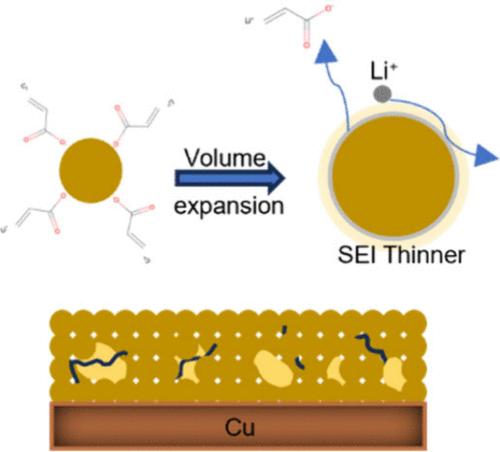当前位置:
X-MOL 学术
›
ACS Appl. Mater. Interfaces
›
论文详情
Our official English website, www.x-mol.net, welcomes your
feedback! (Note: you will need to create a separate account there.)
Improving the Performance of Silicon-Based Negative Electrodes in All-Solid-State Batteries by In Situ Coating with Lithium Polyacrylate Polymers
ACS Applied Materials & Interfaces ( IF 8.3 ) Pub Date : 2024-11-17 , DOI: 10.1021/acsami.4c12341
Zhixun Yu 1, 2, 3 , Deyu He 1, 2, 3 , Xuyang Zhao 1, 2, 3 , Yunpeng Rong 1, 2, 3 , Min Luo 1, 2, 3 , Jingran Fu 1, 2, 3 , Jingling Zhao 1, 2, 3 , Haoxiang Zhuo 1, 2, 3 , Chunrong Zhao 1, 2, 3 , Rong Yang 1, 2, 3
ACS Applied Materials & Interfaces ( IF 8.3 ) Pub Date : 2024-11-17 , DOI: 10.1021/acsami.4c12341
Zhixun Yu 1, 2, 3 , Deyu He 1, 2, 3 , Xuyang Zhao 1, 2, 3 , Yunpeng Rong 1, 2, 3 , Min Luo 1, 2, 3 , Jingran Fu 1, 2, 3 , Jingling Zhao 1, 2, 3 , Haoxiang Zhuo 1, 2, 3 , Chunrong Zhao 1, 2, 3 , Rong Yang 1, 2, 3
Affiliation

|
In all-solid-state batteries (ASSBs), silicon-based negative electrodes have the advantages of high theoretical specific capacity, low lithiation potential, and lower susceptibility to lithium dendrites. However, their significant volume variation presents persistent interfacial challenges. A promising solution lies in finding a material that combines ionic-electronic conductivity, stable physicochemical properties, and adhesive characteristics. Poly(acrylic acid) (PAA) is widely used in liquid-state batteries due to its superior properties compared to polyvinylidene fluoride (PVDF). In this study, silicon particles were coated with varying concentrations of PAA and LiPAA using an in situ liquid-phase coating method to form electrode sheets. The experimental and analytical results revealed significant trends in the impact of different additive concentrations on the electrochemical performance, with 1.0 wt % LiPAA showing notable improvements in Coulombic efficiency, rate capability, and long-term cycling stability. The assembled all-solid-state batteries exhibited a high initial discharge capacity of 3200 mAh/g, with a capacity retention of 81.9% after 300 cycles at 0.3 C, and a stable discharge capacity of 1300 mAh/g at a 2 C rate. A rapid and efficient in situ liquid-phase coating method for LiPAA was developed and confirmed through FTIR, XRD, and TEM characterization. SEM and XPS analyses demonstrated that LiPAA encapsulation effectively alleviates interfacial issues. This study demonstrated for the first time that an appropriate amount of LiPAA coating on silicon particles can mitigate the interfacial challenges caused by the volume expansion of silicon-based negative electrodes. These findings improve electrochemical performance and promote the application of silicon-based negative electrodes in all-solid-state batteries.
中文翻译:

通过用锂聚丙烯酸酯聚合物进行原位涂层来提高全固态电池中硅基负极的性能
在全固态电池 (ASSB) 中,硅基负极具有高理论比容量、低锂化电位和对锂枝晶的敏感性较低等优点。然而,它们显著的体积变化带来了持续的界面挑战。一个有前途的解决方案在于找到一种结合了离子电子导电性、稳定物理化学性质和粘合特性的材料。与聚偏二氟乙烯 (PVDF) 相比,聚丙烯酸 (PAA) 具有优异的性能,因此被广泛用于液态电池。在这项研究中,使用原位液相涂层方法用不同浓度的 PAA 和 LiPAA 包覆硅颗粒以形成电极片。实验和分析结果表明,不同添加剂浓度对电化学性能的影响呈显著趋势,其中 1.0 wt % LiPAA 在库仑效率、倍率能力和长期循环稳定性方面表现出显着改善。组装后的全固态电池表现出 3200 mAh/g 的高初始放电容量,在 0.3 C 下循环 300 次后容量保持率为 81.9%,在 2 C 倍率下稳定放电容量为 1300 mAh/g。开发了一种快速高效的 LiPAA 原位液相涂层方法,并通过 FTIR、XRD 和 TEM 表征进行了确认。SEM 和 XPS 分析表明,LiPAA 封装有效缓解了界面问题。这项研究首次证明,在硅颗粒上涂覆适量的 LiPAA 涂层可以减轻硅基负极体积膨胀引起的界面挑战。 这些发现提高了电化学性能,促进了硅基负极在全固态电池中的应用。
更新日期:2024-11-17
中文翻译:

通过用锂聚丙烯酸酯聚合物进行原位涂层来提高全固态电池中硅基负极的性能
在全固态电池 (ASSB) 中,硅基负极具有高理论比容量、低锂化电位和对锂枝晶的敏感性较低等优点。然而,它们显著的体积变化带来了持续的界面挑战。一个有前途的解决方案在于找到一种结合了离子电子导电性、稳定物理化学性质和粘合特性的材料。与聚偏二氟乙烯 (PVDF) 相比,聚丙烯酸 (PAA) 具有优异的性能,因此被广泛用于液态电池。在这项研究中,使用原位液相涂层方法用不同浓度的 PAA 和 LiPAA 包覆硅颗粒以形成电极片。实验和分析结果表明,不同添加剂浓度对电化学性能的影响呈显著趋势,其中 1.0 wt % LiPAA 在库仑效率、倍率能力和长期循环稳定性方面表现出显着改善。组装后的全固态电池表现出 3200 mAh/g 的高初始放电容量,在 0.3 C 下循环 300 次后容量保持率为 81.9%,在 2 C 倍率下稳定放电容量为 1300 mAh/g。开发了一种快速高效的 LiPAA 原位液相涂层方法,并通过 FTIR、XRD 和 TEM 表征进行了确认。SEM 和 XPS 分析表明,LiPAA 封装有效缓解了界面问题。这项研究首次证明,在硅颗粒上涂覆适量的 LiPAA 涂层可以减轻硅基负极体积膨胀引起的界面挑战。 这些发现提高了电化学性能,促进了硅基负极在全固态电池中的应用。



































 京公网安备 11010802027423号
京公网安备 11010802027423号